Sage, Henry James
Henry James Sage (1868-1953) was born on 4 October 1868 in Kensington. His father, a clerk, later became a manager in a firm of builders and surveyors. Sage received lessons from an artist named Montague. He then moved to Guildford and began to produce drawings of the surrounding villages. Some were reproduced in E.A. Judge, Some West Surrey Villages (1901). In 1898 Sage married Kate Stuart (1874-1943) of Artington, Guildford. The couple had five children. Sage's work at this time was mainly in oil or black and white. He appears to have supported himself from his work, selling mainly to the moneyed middle-class clientele in which the county abounded. From around 1920, he seems to have concentrated more chronologically, as, although frequently signed, very few of his works are dated. After his marriage, Sage lived briefly in Chilworth; he later lived in Station Road, Shalford for some ten years; from the early 1930s he lived at Fernlea, Eastwood Road, Bramley until shortly before his death when he was cared for by a son at Milford.
Works
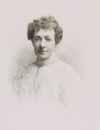
Artist: Sage, Henry James
Media: Drawing
Period: Early 20th Century
Subject: Female Portrait
Work size: 430 x 325 mm
Portrait of Ruby Lawrence (nee Guy)
This drawing of a young woman is based on a photography by Henry Sage.

Artist: Sage, Henry James
Media: Watercolour
Period: Early 20th Century
Subject: Landscape
Work size: 210 x 370
Shalford Common Guildford
This view of Shalford Common probably looks over the Chantries. South of Guildford, a little way upstream, lies Shalford. Shalford Mill is powered by the Tillingbourne stream. King John granted the rector of Shalford Church the right to hold a fair. Originally held in the churchyard, the fair grew in fame and size and had to be moved to Shalford Common where it was reputed to occupy 140 acres. John Bunyan, author Pilgrim's Progress, may have lived in Shalford and obtained the idea for Vanity Fair from Shalford Fair. It was at Shalford Quay that the Wey & Arun Canal entered the Wey. The Wey & Arun Canal completed the last link and established a navigable waterway from London to the South Coast. Shalford Common has recently in mid-summer become the site of the Ambient Green Picnic.

Artist: Sage, Henry James
Media: Watercolour
Period: Early 20th Century
Subject: Landscape; Building
Work size: 260 x 440 mm
Surrey House with Extensive Lawn (Merrist Wood)
The timber framed building with its tall brick chimneys has its roots in the vernacular tradition of Surrey farmhouses. The building was designed by Richard Norman Shaw in 1875-77 and enlarged in 1917-18. Merrist Wood is now an agricultural college and additional classrooms have been built on the front lawn.

Artist: Sage, Henry James
Media: Watercolour
Period: Early 20th Century
Subject: Landscape
Surrey Stream with water meadows

Artist: Sage, Henry James
Media: Watercolour
Period: Early 20th Century
Subject: Landscape; Building
Work size: 170 x 240 mm
Ferry Lane St Catherine's
This picture shows the houses alongside the road leading down to the river. The Wey & Arun Canal Act (1813) led to the linking of the Arun and the Wey. The Wey & Arun Canal had strategic importance beyond the immediate economic benefits it brought to Guildford. There was now an inland route between London and the South Coast, avoiding the hazardous sea route around the coast. This was of particular benefit when England was at war with the age old enemy France. The first public meeting to enlist support for the canal took place at the White Hart Inn. Many of the subsequent meetings including the company meetings also took place at the White Hart. There are pleasant walks along the Wey. A short way out of town, upstream, the Wey is crossed by an ancient trackway, now the crossing point for the North Downs Way. There was once a ferry at this point, now a bridge. The landing stage can still be seen on the opposite bank (the Penguin Guide to Surrey, 1956, refers to the ferry still running). A small chalk stream runs into the Wey at this point. A little way up the track alongside the chalk stream, atop a small hill, lies the ruins of St Catherine's Chapel, built before 1308

Artist: Sage, Henry James
Media: Watercolour
Period: Early 20th Century
Subject: Landscape
Tree Lined Lane with cottages

Artist: Sage, Henry James
Media: Watercolour
Period: Early 20th Century
Subject: Landscape; building
Work size: 177 x 267 mm
Cottage with white picket fence
It is believed that this cottage in in Worplesdon.

Artist: Sage, Henry James
Media: Watercolour
Period: Early 20th Century
Subject: Landscape; Building
Work size: 180 x 270 mm
Surrey Village with cottages
This painting depicts a Surrey villager street with a cottage and a child. It could well be the main road through Compton, with the lane turning off to the right being the lane leading to the back of East Bury.
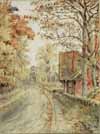
Artist: Sage, Henry James
Media: Watercolour
Period: Early 20th Century
Subject: Landscape; building;
Work size: 240 x 180
Surrey Lane with building
This painting probably features Portsmouth road with Old Friars on the right. Portsmouth Road travels through Guildford, and used to be a toll road. The toll gates just south of Guildford were removed in 1870, when free travel was granted along this stretch of road.

Artist: Sage, Henry James
Media: Watercolour
Period: Early 20th Century
Subject: Landscape; garden
Work size: 340 x 475 mm
The Garden Wonersh Park
The round wood pergolas in this painting were a fashionable feature of British gardens between the First and Second World Wars. The artist often accompanied his grandchildren on walks to Wonersh Park on weekend afternoons.
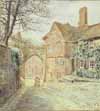
Artist: Sage, Henry James
Media: Watercolour
Period: Early 20th Century
Subject: Architecture
Work size: 270 x 245 mm
Castle Arch
This view of Castle Arch has probably changed very little since it was painted. Guildford Museum is on the right with Quarry Street seen through the arch. The two children in this painting have been positioned to focus the viewer's gaze through the open arch, and along the sloping cobbled road.

Artist: Sage, Henry James
Media: Watercolour
Period: Early 20th Century
Subject: Architecture
Work size: 191 x 254 mm
Guildford High Street
This view looking down Guildford High Street in the 1930s shows to the left the old Cornmarket building before the two central columns were moved further apart. The old iron gates of the Cornmarket itself are still visible and beyond them you can see, what was then, the old council offices.

Artist: Sage, Henry James
Media: Watercolour
Period: Early 20th Century
Subject: Architecture
St Mary's Church Graves
St Mary's churchyard, was extended in the 1790s to accommodate the soldiers from Guildford Barracks who had been killed in the Napoleonic wars. Like all town centre churchyards, it was closed for burials in the mid-19th century for public health reasons.

Artist: Sage, Henry James
Media: Watercolour
Period: Early 20th Century
Subject: Architecture
St Mary's Church Quarry St
St Mary's square church tower is the oldest in Guildford, and was built sometime before the 11th century Norman Conquest. Much of the main body of the church was rebuilt in the 12th century, and decorated windows were added later. The church chancel was shortened in 1825 when Quarry Street was widened - supposedly to enable George IV's coach and horses to travel more easily on its route between Windsor and Brighton. The author of Alice's Adventures in Wonderland - Lewis Carroll - was known to have preached at St Mary's church, when he stayed in Guildford with his sisters.

Artist: Sage, Henry James
Media: Watercolour
Period: Early 20th Century
Subject: Architecture; landscape
Binscombe Farm Godalming

Artist: Sage, Henry James
Media: Watercolour
Period: Early 20th Century
Subject: Landscape
View from Crows Nest Pewley Hill
This view looks south-westwards to St. Catherine's Hill, and the ruins of the medieval chapel. The chapel was built in the early 13th century, as a chapel of ease for the parish of Artington. It had already been abandoned by the end of the Middle Ages. The Crow's Nest was one of the many detached houses being built on Pewley Hill in the early 20th century. Sage must have painted this view before the house's name was changed in the early 1930s.

Artist: Sage, Henry James
Media: Watercolour
Period: Early 20th Century
Subject: landscape; building
Ferry Cottage

Artist: Sage, Henry James
Media: Watercolour
Period: Early 20th Century
Subject: Architecture; landscape
St Catherine's Chapel 1920
There was a fair held around the Chapel from 1308 (though built in 1301 the chapel was not consecrated until1329). The fair continued to be held annually, up to the first world war, without missing a year. The fair is the subject of a Turner painting kept at the Tate. Fairs were held around religious festivals. This one was around St Matthews day 21st September, and later in October. There was revenue collected by the leaseholder for these fairs. In this case there was a dispute as the lease had not been paid when the chapel was built, and it was contested by another church only to be reclaimed later by St Nicolas'. The lease and ownership of the chapel were important to holding rights to the fair. The Chapel was only actively used as a chapel for around 150 years (although a service is still held at Easter to honour its consecration). There was thought to be a chapel to St Katherine as early as 1202, yet this had already fallen into a ruin, or been destroyed by 1300. Why build a new chapel. Was the Chapel always a condition of setting up and drawing revenue from running a fair? Or was their genuine need for the people at Artington? It went on to be a decorative ruin (rebuilt accordingly) and possibly even used as a barn for farm animals. It used to be on open land visible from far away, before the trees grew up around it. Is a major part of its mystery and focus for stories because it did not retain a positive use, so was left open for people to project ideas on to...?

Artist: Sage, Henry James
Media: Watercolour
Period: Early 20th Century
Subject: Landscape; building
St Catherine's Hill Cottages c 1920

Artist: Sage, Henry James
Media: Watercolour
Period: Early 20th Century
Subject: Architecture
Loseley House c 1920
This early 20th century watercolour shows Loseley Park looking very much as we know it today. However, the outside of the house in the watercolour is covered with ivy and flowers, which was fashionable in the Victorian period. The Loseley Estate was acquired by direct ancestors of the current owners at the beginning of the 16th Century and Loseley House was built between 1562 and 1568. The previous much smaller house was not considered by Elizabeth I as adequate for her to stay in and she 'requested' that something more substantial should be built! The House, which is the More-Molyneux family's home, has a number of rooms which are open to the public during the Summer Season (Tours). The Great Hall and the Drawing Room are particularly special, but Other Rooms, including the King's Room and the Queen's Room, are of particular historical interest.

Artist: Sage, Henry James
Media: Watercolour
Period: Late 19th century
Subject: Landscape
Work size: 175 x 270
Distant View of St Martha's
St Martha’s church is perched high on a hill, about 2 miles to the east of Guildford, near the meeting point of two historically significant pathways: the North Downs Way and the Pilgrims’ Way. There has been a church on the Hill for more than a thousand years; the oldest part of the present fabric dates from 1190. Visitors to St Martha approach by foot up sandy tracks, either from Halfpenny Lane or Guildford Lane. The top of the hill provides stunning views of Newlands Corner, the Surrey Hills and the Tillingbourne Valley. People of all ages climb the hill each Sunday to worship - there is a service every Sunday at 11.00am – either Matins or Holy Communion. St Martha’s is floodlit each Christmas, and on Christmas Eve the church is always packed for Midnight Mass. A recent fundraising campaign achieved in excess of £420,000. Amongst other projects, some of the money will be used to enable St Martha’s to be kept open more often so that passing walkers may go inside and enjoy the church.

Artist: Sage, Henry James
Media: Watercolour
Period: Early 20th Century
Subject: Architecture
Work size: 230mm x 260mm
Guildford High Street
This is an early 20th century view of Guildford High Street. It features the steps to Jeffrey's Shop on the left. The steps were used by the family to enter the building, and were quite separate from the public shop entrance. Looking above the steps, you can see the iron framework that held the window boxes that were a feature of shops that had families living above them. The framework can be seen to this day. The oriel window was removed from the building on the right of the painting, as it would have been made unsafe following the remodelling of the lower half of the frontage.

Artist: Sage, Henry James
Media: Watercolour
Period: Early 20th century
Subject: Landscape; Buildings
Work size: 180mm x 265mm
Farmhouse East Shalford Lane

Artist: Sage, Henry James
Media: Watercolour
Period: Early 20th Century
Subject: Buildings
Work size: 230mm x 360mm
Shalford Church
St Mary the Virgin is the third church on this site in Shalford. The first church had a central tower and was demolished in 1788 after falling into disrepair, and the second church stood for only 50 years. St Mary's was built in the early 19th century, during the first years of Queen Victoria's reign. The ancient churchyard wall of Bargate stone is the only part of the original medieval church that survives to this day.

Artist: Sage, Henry James
Media: Watercolour
Period: Early 20th Century
Subject: Architecture
Work size: 250mmx 360mm
St Mary's Church, Quarry Street Guildford
St Mary’s Church in Quarry Street is the oldest surviving building in Guildford and is almost certainly the original church of the town. The Saxon settlers in the area became Christians during the 7th century AD and would at first have built a wooden church, very probably on the present site. The present stone tower was built between 950 and 1100: the shallow vertical strips or lesenes are characteristic of Saxon building, as are the narrow, double-splayed windows visible inside. There is no reason to suppose that the tower was intended for any military purpose, as has sometimes been claimed. After the Conquest the chancel, to the east of the tower, was rebuilt in stone in the Norman style: traces of the windows can still be seen in the side walls. In about 1220 two transepts were added to the north and south of the tower, and arches opened into them through the tower walls. It was probably at this time that the King, Henry I, gave the privilege of appointing the priest – the advowson – of St Mary’s to the Canons of Merton Priory, who held it until the Reformation. About twenty years later the chancel was reconstructed and two side chapels with rounded or apsidal ends added on either side: St John’s to the north and St Mary’s to the south. There was by this time a nave to the west of the tower and later in the 12th century narrow aisles were added, a pillared arcade being opened in the walls of the nave (see plan). The wall-paintings, traces of which are still visible in St. John’s Chapel, were probably executed around 1200. Early in the 13th century the chancel and the side chapels were remodelled in the current ‘Early English’ style, with ribbed vaulting. Under Henry III in the mid 13th century the aisles were extended to their present width and height, and the north doorway made.

Artist: Sage, Henry James
Media: Watercolour
Period: Early 20th Century
Subject: Architecture
Work size: 180 x 265
Unstead Sewerage Farm
Unstead Farm is one of the many timber framed farmhouses so characteristic of South West Surrey, with their massive brick chimneys and clay tiled roofs. This building was originally a dairy farm, but by the time this watercolour was painted in the early 20th century, it had become a sewerage farm.

Artist: Sage, Henry James
Media: Watercolour
Period: Early 20th Century
Subject: Architecture; Guildford
Work size: 285mm x 335mm
Guildford High Street and Guildhall
The High Street is perhaps the most painted view in Guildford, and usually features the town Hall Clock. The granite setts (cobblestones) of the 1860s are still a feature in the High Street today. This view was probably painted in the 1930s and features the portico of the Cornmarket, on the left. Behind the iron gates of the old Cornmarket were Borough Council offices.
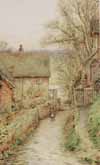
Artist: Sage, Henry James
Media: Watercolour
Period: Early 20th Century
Subject: Landscape; Architecture
Work size: 366mm x 225mm
Ferry Lane St Catherine's

Artist: Sage, Henry James
Media: Watercolour
Period: Early 20th Century
Subject: Landscape; buildings
Work size: 180mm x 270mm
Stream with farm buildings
This picture is untitled by the artist. It features a stream in the foreground and farm buildings in the background.

Artist: Sage, Henry James
Media: Watercolour
Period: Early 20th Century
Subject: Building; landscape
Work size: 260mm x 368 mm
Cottage with geese and hens - Monksgrove Cottages
This painting is untitled, but is signed H.J. Sage in the lower right hand corner. It features a cottage with geese and hens, surrounded by trees. Monksgrove Cottages are on Puttenham Common.

Artist: Sage, Henry James
Media: Watercolour
Period: Early 20th Century
Subject: Landscape
Work size: 260mm x 380 mm
Bridge over stream with figures
This painting is untitled. It features a bridge over a stream with figures.

Artist: Sage, Henry James
Media: Watercolour
Period: Early 20th Century
Subject: Landscape
Work size: 230mm x 550mm
Possible view of Hogs Back

Artist: Sage, Henry James
Media: Watercolour
Period: Early 20th Century
Subject: Architecture
Work size: 205 x 263 mm
Perridges Corner of Quarry Street
Mr George Perridge, owned the shop shown in the picture. He traded there for many years, selling fine china and other objects d'art. The timber framed building has a jutting out upper floor characteristic of late 16th-early 17th century buildings. It was extensively refurbished when it was taken over by WH Smiths, and is currently home to the travel agents Thomas Cook.

Artist: Sage, Henry James
Media: Ink
Period: Early 20th Century
Subject: Architecture
Work size: 230 x 325 mm
Guildford Museum (black and white)
This view shows Castle Arch with the Museum, a lady by the gate and an extra door on the right. The right hand building was not originally part of the Museum; it was the caretaker's house and thus had a separate door. This painting shows a board on the wall advertising the museum and the view can therefore be dated to after 1898.

Artist: Sage, Henry James
Media: Ink
Period: Early 20th Century
Subject: Landscape
Work size: 240 x 335 mm
Quarry Street looking South
This picture shows the so-called Bunyan Cottages on the right, and on the left is a lodging house known as the Good Intent. The sharp perspective and use of shadows in this painting is almost photographic, and coupled with a use of monotone colouring, suggests that it may have been painted from a black and white postcard or photograph.
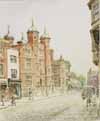
Artist: Sage, Henry James
Media: Watercolour
Period: Early 20th Century
Subject: Architecture
Work size: 200 x 166 mm
Abbots Hospital
George Abbot, Archbishop of Canterbury under James I, founded his Hospital of the Blessed Trinity in 1619. The building remains largely unaltered to this day, and still fulfils its original purpose of housing elderly Guildfordians. A small number of men and women over the age of 60, are given residential accommodation at the Hospital. They are cared for by a resident nurse and attend a daily chapel service. The Hospital is run by a Master and a voluntary board of governors. Sage has greatly altered the proportions of the hospital, and has widened the street for artistic effect.

Artist: Sage, Henry James
Media: Watercolour
Period: Early 20th Century
Subject: Architecture, Landscape
Work size: 200 x 275 mm
Shalford Church Gate
In the background of this painting is the gateway to Shalford House, the home of the Austens until the end of the 19th century. In the right foreground are the parish stocks and whipping post, where petty offenders were punished by the parish constable. A replica still stands on this site. Shalford house was demolished in 1967 to building a pumping works.

Artist: Sage, Henry James
Media: Watercolour
Period: Early 20th Century
Subject: Architecture
Work size: 190 x 270 mm
Guildford Museum
In this view of the Museum, the extra door seen in the black and white ink drawing in the Guildford Borough collection, has gone from the wall on the right. The wall of the building on the right has also changed over time and has become tile hung. In the black and white painting the wall was plaster. This watercolour probably therefore post dates the black and white version. The gardens opposite the museum used to be part of Castle Cliffe House, the home of Harry Stevenson and his boat business.

Artist: Sage, Henry James
Media: Watercolour
Period: Early 20th Century
Subject: Architecture
Work size: 255 x 357
St Mary's from Quarry Street

Artist: Sage, Henry James
Media: Watercolour
Period: Early 20th Century
Subject: Landscape
Work size: 211 x 370 mm
Shalford Common
The railway bridge would be to the right of this view and the Parrot Inn to the left of the view.
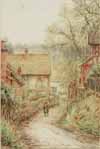
Artist: Sage, Henry James
Media: Watercolour
Period: Early 20th Century
Subject: Landscape; buildings
Work size: 270 x 180
Pilgrims Way St Catherine's

Artist: Sage, Henry James
Media: Watercolour
Period: Early 20th Century
Subject: Landscape; buildings
Work size: 175 x 275 mm
St Martha's from Ferry Lane

Artist: Sage, Henry James
Media: Monochrome Wash
Period: Early 20th Century
Subject: Architecture
Work size: 195 x 245
Shalford Church
Shalford Church, on Seale-Puttenham ley. Orientation a little south of east. Victorian with a copper lead spire, on a piece of high ground near the Tillingbourne, but there was a previous church on the site. Medium head-hum towards altar, interesting since the structure itself is Victorian.

Artist: Sage, Henry James
Media: Watercolour
Period: Early 20th Century
Subject: Architecture
Work size: 122 x 162
Playhouse Arcade Guildford 1927
This painting depicts the Playhouse Arcade in Guildford High Street and provides a valuable historic record of this building. The initials GPP which stand for Guildford Picture Palace, can be seen either side of the entrance to Tunsgate Arcade on the High Street.

Artist: Sage, Henry James
Media: Watercolour
Period: Early 20th Century
Subject: landscape; buildings
Work size: 143 x 226 mm
Old Portsmouth Road Artington
This painting looks towards the high ground beyond Godalming. Sage lived for a time in a cottage on St. Catherine's Hill, next to the Portsmouth Road and painted many views nearby. The house in this painting is probably Old Friars.

Artist: Sage, Henry James
Media: Watercolour
Period: Early 20th Century
Subject: building; landscape
Work size: 215 x 270mm
Witley Church
All Saints Church, Witley was originally a Saxon church and was mentioned in the Domesday Book. The church has been much altered over the years but original Saxon windows remain in the South and West walls. The interior boasts 12th century painted murals, which were created using the fresco technique of painting on fresh wet plaster.
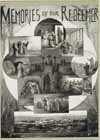
Artist: Sage, Henry James
Media: Print
Period: Late 19th century
Subject: Religion; people
Memories of our Redeemer
This work was executed in approximately 1898 for the Wesleyan Church, but was rejected owing to an objection to the symbolism of the Cross in the central feature.

Artist: Sage, Henry James
Media: Watercolour
Period: Early 20th Century
Subject: Landscape; Building; River
Work size: 260 x 370
The Ferry St Catherine's
An interesting view of a cottage garden, complete with fence, storage shed and garden tools. Although the title of the work is The Ferry, St Catherine's the real visual focus is on the cottage and its garden, with its lush trees flowering in pink, the creeper on the house and the trees surrounding it.

Artist: Sage, Henry James
Media: Watercolour
Period: Early 20th Century
Subject: Landscape; Architecture
Work size: 180mm x 265mm
Rustic Lane Portsmouth Road
The figure in this painting could have been a tallyman or peddler. These travelling salesmen were still to be seen carrying their wares along the roads of West Surrey as late as the 1930s.

Artist: Sage, Henry James
Media: Watercolour
Period: Early 20th Century
Subject: Architecture
Work size: 185 x 274 mm
Farnham Road Cottages Guildford
The subject of this painting has been very popular with artists over the years, as the steep incline provides a dramatic view for composition. Despite the romantic exterior of the Farnham Road cottages, they were cramped and unsanitary places to live. This was the main reason why they were finally demolished by Guildford Borough Council in 1956.

Artist: Sage, Henry James
Media: Watercolour
Period: Early 20th Century
Subject: Landscape
Work size: 170 x 240mm
Ferry Lane St Catherine's
This cottage in Ferry Lane still exists today.